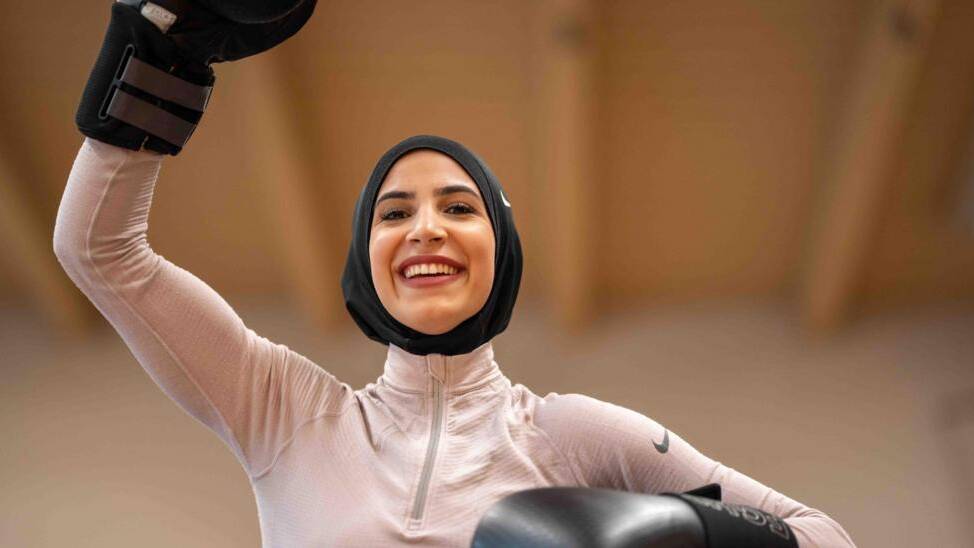Hijabs in pro boxing - the rules
BBC | 26.11.2025 15:11
With a pile of notes stacked beside her, Zeina Nassar sat her parents down in their Berlin living room, ready to give a presentation on why they should let her box.
The 13-year-old - inspired by YouTube training footage of female fighters - felt an instant connection to the sport. The rhythm of the pads, the snap of the punches, the power in every movement.
"I watched it again and again," Nassar, now 27, tells BBC Sport. "I knew this is what I want to do."
So Nassar made her case like a young lawyer, pleading for her future.
"I told them it would help my concentration at school, that I'd only go to an all-girls gym nearby and that boxing was about respect and discipline," she remembers.
Her parents were impressed, but convincing them was the easy part.
Born in Germany and of Lebanese descent, Nassar - a Muslim teenager who proudly wore a hijab - would soon find that her greatest challenge lay beyond her family.
She joined her local boxing gym, but at the time national and international rules did not permit hijabs in competition. She would have to fight for her right to compete.
"People told me I had to choose my hijab or my sport," she says. "I thought, why should I decide? I'm not hurting anyone. I just want to box."
That instinct to challenge injustice would come to define her career.
On Wednesday, Nassar will wear her hijab and full body covering when she makes her professional debut in Pakistan. In her corner will be living legend Roy Jones Jr, as trainer and mentor.
She is believed to be the first as there are no known high-profile examples of a professional woman boxing in a hijab, making Nassar's debut even more significant.
Not bad for a kid with a PowerPoint and a dream.
At just 14, Nassar helped change German amateur boxing regulations so she could compete in long sleeves and a headscarf.
But when she stepped through the ropes for her first amateur bout, adrenaline surging, she could feel the eyes on her.
"I noticed so many people were looking," she says. "Some even told me I couldn't fight like this, and I said 'please, we just changed the rules'.
"I just didn't understand it - it should be about my performance and how good I am in the ring. Yet so many people were against it."
Nassar excelled in the ring and changed attitudes, becoming a multiple Berlin champion and national title-holder, all while staying true to her beliefs.
But when the International Boxing Association (IBA) invited her to the European Championships, she hit another wall. The hijab was still banned at international level.
So at 19, she started campaigning to have the rules changed on the global stage.
"Germany wasn't supporting me," she says. "But I was ambitious. I wanted the same fairness as every other athlete."
In 2019, the IBA ended the ban on hijabs. Olympic boxing is now governed by World Boxing which also permits hijabs and full-body coverings.
"Because of me, every woman in amateur boxing can now fight with a hijab and be who they want to be," Nassar says. "That's my proudest victory."
Nassar's campaign reshaped the amateur world and in 2017 she caught the attention of Nike, where she became a face of the brand's new hijab for athletes.
But what about the professional ranks? What are the rules? Could a hijab be dangerous? Would it offer any kind of advantage?
BBC Sport contacted several governing and sanctioning bodies. The WBO (World Boxing Organisation) leaves attire decisions to local commissions. The IBF (International Boxing Federation) has no specific rules on religious headwear.
The British Boxing Board of Control, who governs professional boxing in the UK, permits sports-designed hijabs.
German Boxing Federation president Oliver Wittmann admits there is little precedent but voices concerns about its safety and the threat of a hijab slipping off mid-fight.
Nassar counters Wittman's comments with her own experience. "In around 100 amateur fights, it has never caused a problem," she says.
And the medical experts agree. "It's a non-issue," says professor Mike Loosemore, who has worked as Team GB's medical officer.
"Hijabs are made from light, breathable fabric," he said. "I've got no problem with people boxing with hijabs.
"They're safe. They don't cause any problem for the boxer or the opponent."

Pakistan is not often associated with a global boxing event, but more than 20,000 fans are expected in Lahore over four days of professional fights.
The show, backed by the Punjab government, will feature a mix of local and international fighters, including Britons Alex Dilmaghani, Jimmy Kelly and James Metcalf.
Nassar describes it as an "honour" to be fighting in an Islamic country.
"Boxing's for everyone," adds Chris Glover, the Liverpudlian behind the event. "If Zeina wants to wear a hijab, she could wear a cowboy hat for all I care. She's a pioneer."
In her corner will be Jones Jr, the four-weight world champion turned coach. Nassar first met him at an IBA event years ago.
"I couldn't believe I was sitting next to him," she laughs.
"Then he started showing me moves, giving me advice, and we stayed in touch. He's taught me so much about footwork, about power, about belief."
Nassar has set herself a bold target of becoming a world champion within six or seven bouts.
And given the hurdles she has already overcome to reach this point, you wouldn't bet against her.









